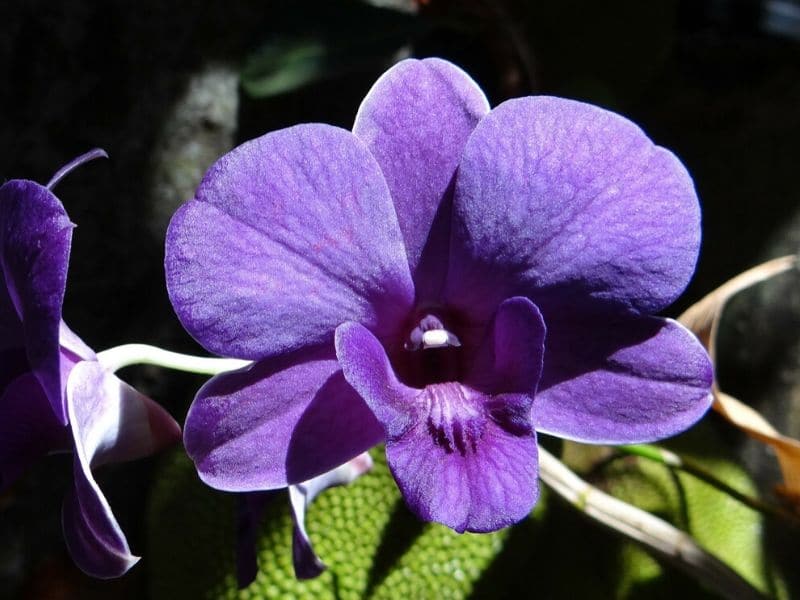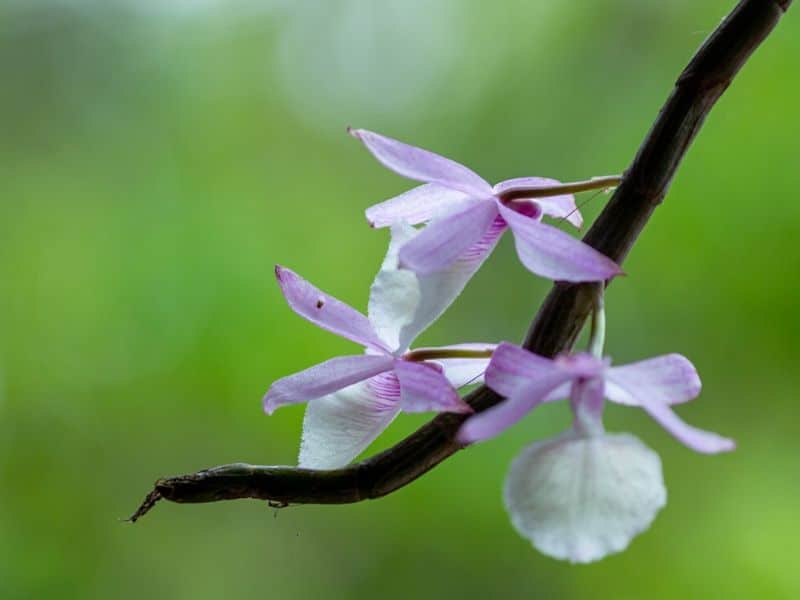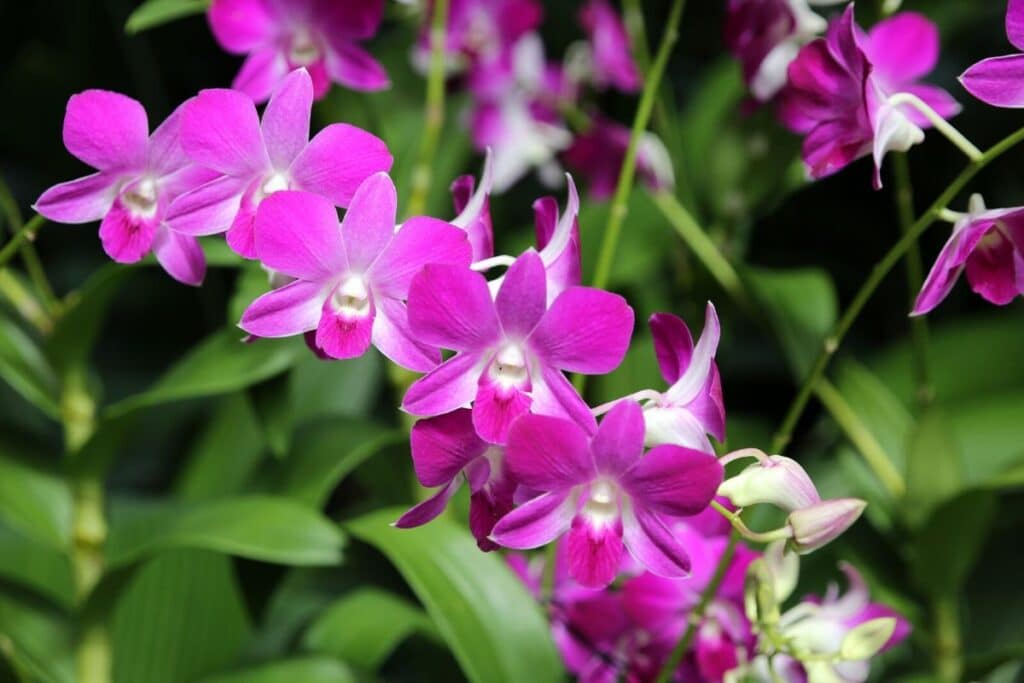Dendrobiums or dendrobium orchids are one of the most popular orchid types among home growers and orchid enthusiasts. Mainly cultivated for their flowers or as a decorative house plant, these exotic beauties produce showy and delicate blooms in varying colors, including creamy white, green, purple, and pink.
Many dendrobium orchids exist, and they vary in cultural requirements. Some species thrive best in hot conditions; some prefer cooler environments. Regardless, these famed orchids are relatively easy to grow.

Dendrobiums are also called Singapore Orchid and Bamboo Orchid.
The Genus Dendrobium: An Overview

Dendrobium (Dendrobium spp.) is a diverse genus in the Orchidaceae family with approximately 1,600 known species (1).
They are the second-largest genus after Cattleya spp. (2) and distributed throughout India, China, Malaysia, Japan, Philippines, South Pacific, and New Guinea.
The name dendrobium comes from the Greek words dendron, which means tree, and bios, which means life referring to the plant’s epiphytic growth habit. Swedish botanist Olof Swartz first described it in 1799.
Characteristics of Dendrobium Orchids
Dendrobiums are sympodial epiphytes (2), lithophytes, and less often terrestrial. Because of the genus’ diversity, dendrobiums can be deciduous or evergreen, depending on the species. Their stems also vary. Some have rhizomatous stems, while others do not have a rhizome. The pseudobulbs can measure from 5 cm to 4.5 meters in height.
The leaves of a dendrobium orchid vary from one to many with internodes swollen at or near the plant base. They can be papery or leathery, lanceolate, oblong, or ovate, depending on the species (4).
Most flowers of dendrobium orchids measure 1 to 2 inches across with three sepals, two petals, and another petal forming a lip or labellum. They usually range in shape and color (4).
Nobile vs. Phalaenopsis Dendrobiums
Generally, dendrobiums are classified into two main groups: nobile dendrobiums and phalaenopsis dendrobiums.
Nobile dendrobiums, also called noble dendrobium or dendrobium nobile (den-nobile), are deciduous, soft cane dendrobiums. These deciduous species have leafy and long pseudobulbs and lighter leaves that their hard cane counterparts. This type of dendrobium hybrids produce as many as 50 flowers per plant, and the bloom time can last up to 3 weeks.
Phalaenopsis dendrobiums, also called Dendrobium phalaenopsis (den-phal), feature flowers that look like phalaenopsis orchids. They are evergreen and feature pseudobulbs that are thin and tall. The leaves are darker than the nobile type. This type of dendrobium hybrids produces up to 20 blooms at a time. Some hybrids are even flowering more than once a year.
Popular Dendrobium Species
#1. Dendrobium crumenatum
Scientific name: Dendrobium crumenatum
Common Names: Pigeon Orchid, Pigeon Dendrobium, Sparrow Orchid, White Dove Orchid, Purse-shaped Dendrobium
Pigeon orchids (Dendrobium crumenatum) are famed white-flowered dendrobiums commonly found in the Philippines, Singapore, Malaysia, Sri Lanka, Vietnam, Indonesia, and other parts in Asia. These dendrobium orchids feature spindle-shaped, elongated stems that reach up to 1 m in length. At the base of the stems are sympodial pseudobulbs that measure up to 12 cm long and 2.5 cm wide. The leaves are thick, leathery, oblong, and deciduous.
One distinct characteristic of this dendrobium species is the dove-like flower. The pure white blooms, which typically measure 5cm across, showcase a hint of yellow at the center of the lip.
Additionally, they are strongly fragrant though the scent only lasts for a day. The flowering of pigeon orchids occurs at irregular intervals but typically commences nine days after the temperature suddenly drops to at least 5.5 degrees Celsius.
The species name crumenatum originated from the Latin word crumena, which means “leather money bag.”
#2. Dendrobium taurinum
Scientific name: Dendrobium taurinum
Common Names: Bull Orchid, Bull Face Orchid
Bull orchids (Dendrobium taurinum) are epiphytic dendrobium orchid species native to the Philippines (5) and the Maluku Islands in Indonesia. They are often found in mangrove forests.
The common name bull orchids refer to the exotic flowers that resemble a bull’s head because of the twisted, hornlike petals. The petals are lavender to purple, while the sepals are white. The lip is broad and white, with a hint of purple and ruffled margins. Each inflorescence bears 20 to 30 beautiful flowers (5). Individual flowers can measure from 5 cm to 6.5 cm across (6).
The pseudobulbs of bull orchids are slightly cylindrical and measure up to 1.5 long and 2.5 cm in diameter. The leaves are oblong-elliptic, broad, glossy, and dark green.
#3. Dendrobium cucumerinum
Scientific Name: Dendrobium cucumerinum
Common Names: Cucumber Orchid, Gherkin Orchid
Cucumber orchids or D. cucumerinum is a miniature type of dendrobium native to eastern Australia. The species name cucumerinum originates from the Latin word cucumis, which means cucumber and refers to the epiphytic orchid’s gherkin-like leaves on a thin, creeping rhizome.
The erect flowering stems can produce up to 18 cream, greenish-yellow, or white flowers with distinctive reddish-purple stripes. Both the sepals and petals are irregularly twisted, while the lip is curved. The flowers are short-lived and bloom during late winter and spring.
#4. Dendrobium anosmum

Scientific Name: Dendrobium anosmum
Common Names: Unscented Dendrobium, Hono-Hono Orchid
Another popular species of dendrobium orchids is the unscented dendrobium (D. anosmum). It is widespread in the Philippines, where it is locally referred to as sanggumay, as well as in New Guinea, Borneo, Indonesia, Malaysia, Sri Lanka, Laos, and Vietnam.
D. anosmum is a large-sized dendrobium that grows up to 3 m tall. The green leaves are oblong-elliptic, deciduous, fleshy, and glossy. Flowers bloom in the spring with up to 10 flowers per spike. The flowers can be dark pink to purple.
#5. Dendrobium aphyllum
Scientific Name: Dendrobium aphyllum
Common Names: Hooded Orchid
Also known for the name hooded orchid, D. aphyllum features a cone-shaped labellum that sets it apart from other types of dendrobium orchids. It can be found in India, Nepal, China, Thailand, Vietnam, Malaysia, Bhutan, Laos, and Cambodia.
Hooded orchids are epiphytic and sometimes lithophytic. They produce clusters of exotic, short-lived flowers, often in groups of three, on many overhanging flower spikes. Each flower has translucent, yellow-cream to white or lavender-pink sepals and petals surrounding a cone-shaped pale yellow lip. The lip is covered with soft, short hairs along the margins and on the external surface.
How To Grow Dendrobium Orchids
Dendrobium is a complex and large genus with thousands of known species and hybrids. Thus, the cultural requirements for dendrobiums vary depending on the section of the genus to which they belong.
Species in the dendrobium genus are divided into six main sections. These are Phalaenanthe, Dendrobium, Spatulata, Callista, Formosae, and Latouria. Below is a quick guide on dendrobium orchids’ general care and maintenance.
Light
Like cattleyas and other types of orchids, dendrobiums prefer lots of light, but exposure to direct sunlight should be avoided (7). Place your dendrobium plant in an area where it can receive adequate light like a lightly shaded south-facing window.
Dendrobiums will still grow under low light conditions, but flowering may be affected. Some dendrobiums will produce keikis (baby plants), which is a sign that the plant is not receiving enough light. On the other hand, yellowing of the leaves, brown shriveled leaf tips, or wrinkled leaves indicates exposure to too much sunlight.
Temperature and Humidity
Generally, dendrobiums prefer warm conditions. They thrive best in 65°F – 75°F day temperature and 55°F and 60°F night temperature (7). The humidity should be 50-70%. The appearance of brown tips indicates that the air is too dry for the dendrobium plant. Also, a drop in night temperature may promote flowering.
Australian dendrobium species like D. kingianum require drier conditions.
Water
As with other types of orchids, dendrobiums will develop root rot as a result of overwatering. Therefore, it is important to avoid overwatering, especially when it is cold. Nobile types of dendrobiums are more tolerant to root rot than phalaenopsis dendrobiums.
The rate of watering depends on the type of dendrobium, potting media, type of pot used, and growing requirements, but watering once or twice a week during the summer is generally acceptable.
The best time to water dendrobiums is in the morning so that the leaves are dry before night time. Allow the plant to drain before watering again.
Some signs of insufficient watering are browning and drying of the leaves, wilting, and drying of the canes.
Fertilizer
Weekly application of balanced orchid fertilizer like Peters 20-20-20 at quarter-strength works well for dendrobium orchids (7). You can also fertilize your dendrobium orchids with a water-soluble fertilizer every 1 to 2 weeks.
Note, however, that excessive feeding of fertilizer may promote keikis development. As a result, the plant will produce lesser and smaller blooms.
Growing Medium and Potting
Most dendrobium orchids grow best if planted in small pots with the orchid’s roots confined. Using a big pot will only slow growth and discourage flowering (7).
You can use an open mix of bark, perlag, and charcoal or orchid mix as potting medium. Since dendrobiums are epiphytic orchids, meaning they grow on the surface of another plant like trees, make sure that the potting mix is well-draining and well-aerated.
Repot dendrobiums every two to three years or when the canes are overgrowing the pot. It should be done when the orchid has finished flowering, since repotting at other times may suspend bud and flower development.
Pruning
Pruning Dendrobium orchids involves specific techniques. After flowering, remove wilted flowers. Avoid cutting off viable canes, as they store nutrients. When signs of disease or rot appear, use clean, sterilized scissors to remove the affected tissue.
Before repotting, trim dead roots. Proper pruning ensures healthy growth and long-lasting beauty, especially when you pay attention to the health of each flowering stem.
FAQs
Do Dendrobium orchids like full sun?
Dendrobium orchids generally prefer bright, indirect sunlight rather than full sun. They thrive in conditions with filtered sunlight or bright, indirect light, such as near an east or west-facing window.
How long do Dendrobium orchids last?
Dendrobium orchids can last for many years with proper care. Depending on the species and growing conditions, individual blooms may last several weeks to a few months, while the overall lifespan of the plant can extend for several years or even decades.
Where is the best place to put a Dendrobium orchid?
The best place to put a Dendrobium orchid is in a location with bright, indirect sunlight and good air circulation. East or west-facing windows are ideal, as they provide the right balance of light intensity and duration. Avoid placing them in direct sunlight, as this can cause leaf burn or overheating.
What do you do with Dendrobium orchids after they bloom?
After Dendrobium orchids finish blooming, you can trim off the spent flower spikes near the base of the plant. Continue to provide regular care, including proper watering, fertilizing, and maintaining appropriate light levels. Some Dendrobium orchids may go through a period of rest after blooming, during which they may require reduced watering or cooler temperatures.
Final thoughts
With their stunning displays of vibrant flowers and their relatively easy-going nature, Dendrobium orchids are a popular choice for home growers.
By providing them with the right balance of light, water, and fertilizer, alongside comfortable temperatures and moderate humidity, you can cultivate these orchids successfully and witness their breathtaking blooms season after season.
Remember, observing your plant and adjusting your care routine accordingly is key to keeping your Dendrobium orchid happy and thriving. With a little dedication and these helpful tips on Dendrobium orchid care, you can enjoy the long-lasting beauty and elegance these captivating flowers bring to your home.
References
Reference List:
- Zahara, Meutia & Win, Cho. (2019). Morphological and Stomatal Characteristics of Two Indonesian Local Orchids. Journal of Tropical Horticulture. 2. 65. 10.33089/jthort.v2i2.26.
- Pal, Ram. (2019). Dendrobium Orchids: Vying for a Place in Indian Floriculture. 24. 40-42.
- Aggie-horticulture.tamu.edu. (2020). Orchidaceae or Orchid Family. [online] Available at: https://aggie-horticulture.tamu.edu/syllabi/302/new/family/orchidaceae.html
- Guanghua, Z., Zhanhe, J., Wood, J., and Wood, H., 2009. 139. DENDROBIUM Swartz, Nova Acta Regiae Soc. Sci. Upsal., ser. 2, 6: 82. 1799, nom. cons. Flora of China, [online] 25, pp.367–397. Available at: http://flora.huh.harvard.edu/china/PDF/PDF25/Dendrobium.pdf
- Kamemoto, H., Amore, T., and Kuehnle, A., 1999. Breeding Dendrobium Orchids In Hawaii. Honolulu: University of Hawai’i Press.
- Orchids, R. (2020). Rarest Orchids – Orchids. [online] Orchids. Available at: https://blogs.lt.vt.edu/kmkloor/rarest-orchids/
- Orchids. (2017). Dendrobium – Orchids. [online] Available at: https://blogs.lt.vt.edu/kmkloor/2017/01/30/dendrobium/
Close
*Photo by PantherMediaSeller/depositphotos







